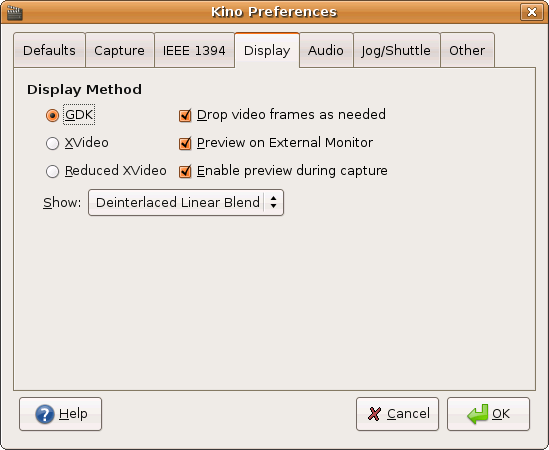The Display page of the Preferences dialog contains the video-oriented settings during playback.

-
Display Method :
GDK is very compatible with X servers and the X-Window client/server architecture. It is not very fast, and it does not always use the correct display aspect ratio.
XVideo (Xv) requires supporting hardware and X server (most non-generic video card drivers support it). Run 'xvinfo' from a terminal window to get information about support on your system. XVideo is very fast and Kino maintains proper display aspect ratio. You can not take a screen capture of the video preview in this mode. XVideo is similar to Microsoft DirectDraw if you are familiar with Windows.
Reduced XVideo is similar to XVideo with the same advantages and disadvantages. This variation, however, uses half of the data bandwidth that is needed for compatibility on some X servers and hardware. The reduction in data bandwidth does invoke a scaling CPU overhead thereby affecting performance.
Show : Due to the nature of NTSC and PAL video, interlacing can result in inter-field motion ( Section 2.9, “Interlace and Fields” ). Setting this to either the lower or upper field options does a fast deinterlace by doubling the lines from one of the fields. The results in an effective 50% reduction in resolution, which is just fine and looks decent if you are just viewing at 50% size anyway. The linear blend option is a slower with fair results when viewing at greater than 50%; however, it tends to blur the image some.
Drop video frames as needed : When enabled, Kino uses sophisticated algorithms and threads to sacrifice the video frame rate in order to provide better audio quality of play back and to provide an overall playback rate that is consistent and true with time ( Section 2.4, “Frame Dropping” ). Basically, only disable this if you are interested in seeing if your machine is fast enough to decode DV in realtime. If you machine is not fast enough, then your will hear audio clicks and gaps.
Preview on External Monitor : enable this option to send the video through IEEE 1394 while using edit and trim modes.
Enable preview during capture : To reduce the chance of dropped frames during video capture to disk, disable this option. If you have a fast enough system, you can turn this on and get a live preview of the video being captured.
-
DV Decoder
![[Important]](images/important.png)
Important The following options only appear when Kino is configured at build time to use libdv for the DV video codec (using build configure option --with-libdv-only).
Quality : You can adjust the quality of the DV decoder to reduce the processing overhead for increased playback performance. This does not affect the quality of DV exported over IEEE 1394 back into your camera.
Clamp luma values : ITU-R BT.601 specifies that the legal range for luma is 16-235. However, some users take advantage of the footroom or headroom below or above these ranges to encode additional information for things such as luma keying. Disabling this options disables the range checking to preserve the superblack and superwhite. This option also applies to the encoder used by the FX renderer.
Clamp chroma values : ITU-R BT.601 specifies that the legal range for chroma is 16-240. This options toggles the range checking. This option also applies to the encoder used by the FX renderer.